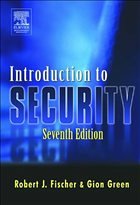Main description:
Introduction to Security, Seventh Edition is a complete revision of the classic text. This edition presents the latest in security issues from security equipment and design theory to security management practice and has been reorganized to reflect the industry changes since the 9-11-01 World Trade Center attacks. It begins with a new chapter on the movement of Homeland Security in the United States and includes new coverage throughout the book of terrorism as it relates to: cargo and travel security, potential areas of attack and target hardening techniques, and the use of current technologies to combat new threats. Traditional physical and guard security is covered in addition to the advances in the electronic and computer security areas including biometric security, access control, CCTV surveillance advances, as well as the growing computer security issues of identity theft and computer fraud.
The Seventh Edition provides the most comprehensive breakdown of security issues for the student while detailing the latest trends, legislation, and technology to interest experienced security professionals alike.
- Examines the attacks of September 11th, 2001 and the lasting impact on the security industry
- Expanded figures and photographs support new coverage of emerging security issues
- Recommended reading for the American Society for Industrial Security's (ASIS) Certified Protection Professional (CPP) and Physical Security Professional (PSP) exams
Review quote:
The authors faced a forbidding task of making the latest version relevant, but they have succeeded. The book has been revamped not only in content but in organization as well. ...it provides an excellent entree into and update on a wide variety of issues. It is clear why the book had reached its seventh edition. - Security Management
Table of contents:
Part I: Introduction and Security's Function
1: Homeland Security -- Changing the Emphasis on Security in the United States
2: Origins and Development of Security
3: Defining Security's Role
4: The Proprietary Security Organization
5: Career Opportunities in Loss Prevention
6: Security Education, Training, Certification, and Regulation
Part II: Basics of Defense
7: Security and the Law
8: Risk Analysis and the Security Survey
9: The Outer Defenses: Building and Perimeter Protection
10: Interior and Exterior Security Concerns
11: The Inner Defenses: Intrusion and Access Control
12: Fire Protection, Safety, and Emergency Planning
13: Insurance
14: Internal Theft Controls
15: Personnel Policies for Internal Security
Part III: Specific Threats and Solutions
16: Transportation/Cargo Security
17: Workplace Violence: Prevention and Intervention
18: Drugs in the Workplace
19: Retail Security
20: Terrorism and Other Tools of Destruction
21: Computer and Information Security
22: Specific Security Threats
23: Security: Its Problems, Its Future
Introduction to Security, Seventh Edition is a complete revision of the classic text. This edition presents the latest in security issues from security equipment and design theory to security management practice and has been reorganized to reflect the industry changes since the 9-11-01 World Trade Center attacks. It begins with a new chapter on the movement of Homeland Security in the United States and includes new coverage throughout the book of terrorism as it relates to: cargo and travel security, potential areas of attack and target hardening techniques, and the use of current technologies to combat new threats. Traditional physical and guard security is covered in addition to the advances in the electronic and computer security areas including biometric security, access control, CCTV surveillance advances, as well as the growing computer security issues of identity theft and computer fraud.
The Seventh Edition provides the most comprehensive breakdown of security issues for the student while detailing the latest trends, legislation, and technology to interest experienced security professionals alike.
- Examines the attacks of September 11th, 2001 and the lasting impact on the security industry
- Expanded figures and photographs support new coverage of emerging security issues
- Recommended reading for the American Society for Industrial Security's (ASIS) Certified Protection Professional (CPP) and Physical Security Professional (PSP) exams
Review quote:
The authors faced a forbidding task of making the latest version relevant, but they have succeeded. The book has been revamped not only in content but in organization as well. ...it provides an excellent entree into and update on a wide variety of issues. It is clear why the book had reached its seventh edition. - Security Management
Table of contents:
Part I: Introduction and Security's Function
1: Homeland Security -- Changing the Emphasis on Security in the United States
2: Origins and Development of Security
3: Defining Security's Role
4: The Proprietary Security Organization
5: Career Opportunities in Loss Prevention
6: Security Education, Training, Certification, and Regulation
Part II: Basics of Defense
7: Security and the Law
8: Risk Analysis and the Security Survey
9: The Outer Defenses: Building and Perimeter Protection
10: Interior and Exterior Security Concerns
11: The Inner Defenses: Intrusion and Access Control
12: Fire Protection, Safety, and Emergency Planning
13: Insurance
14: Internal Theft Controls
15: Personnel Policies for Internal Security
Part III: Specific Threats and Solutions
16: Transportation/Cargo Security
17: Workplace Violence: Prevention and Intervention
18: Drugs in the Workplace
19: Retail Security
20: Terrorism and Other Tools of Destruction
21: Computer and Information Security
22: Specific Security Threats
23: Security: Its Problems, Its Future

